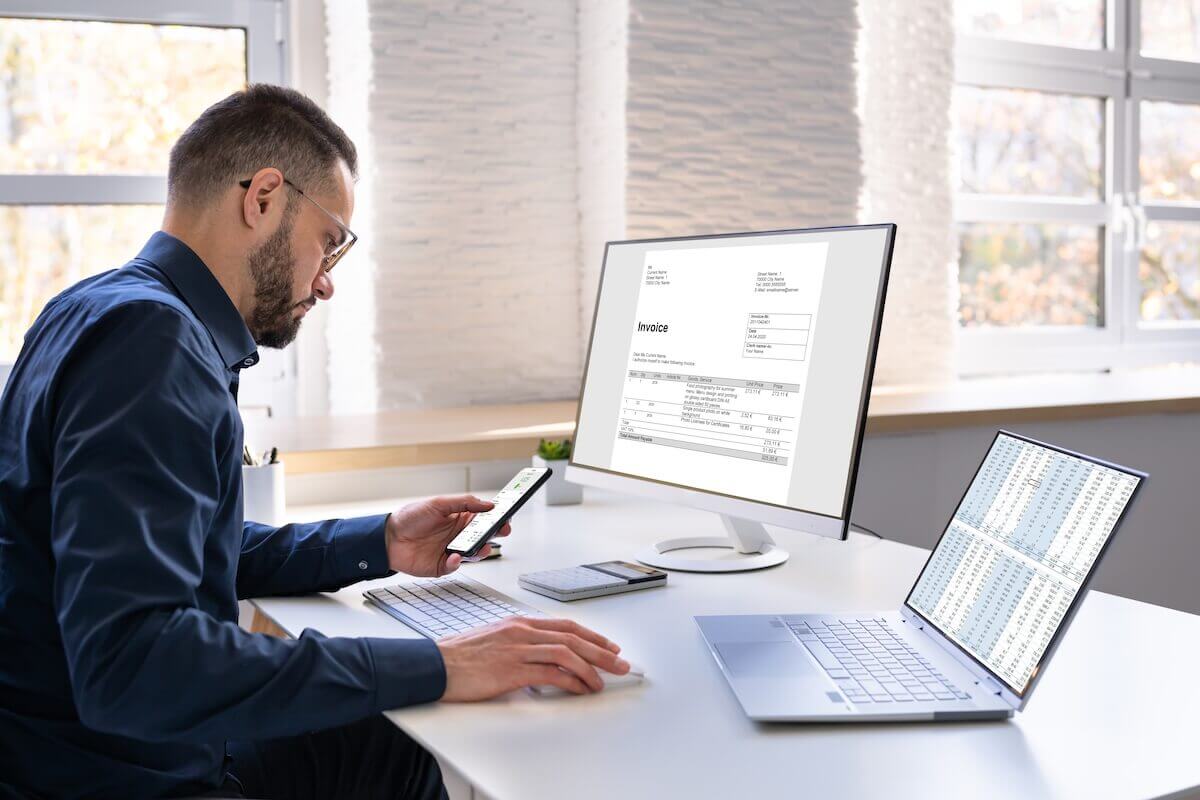Benefits in Sweden: Clear Guide for US Employers
This guide to employee benefits in Sweden will cover all you need to stay compliant and provide the best additional benefits to attract talent.

If you've ever dabbled in international trade or run a business that sells products abroad, chances are you've encountered a commercial invoice. But what exactly is a commercial invoice? And more importantly, what sort of information is required to complete one?
In this article, we're going to unravel the mystery behind commercial invoices. Plus, we'll dive into how Wise Business can help you send out payments on time, for less, and in batches, if needed.
Save on international business
transactions >>
Trustpilot: 4.2/5 average rating - Excellent¹
No minimum balance required and no monthly fees
| Table of Contents |
|---|
A commercial invoice is like a detailed receipt you get when you buy something, but for things bought and sold between countries. It's a paper that is issued by the person or company who is selling. This way, the border authorities know exactly what's crossing in or out of their country.
This important document serves multiple purposes. First off, it details the goods being sold: what they are, how many have been sold, and the price they've been sold at. It's the seller saying: "Here's what's on the way!" But it's more than just a bill. Customs officers use it to calculate tariffs and make sure all regulations are met, and it can act as a receipt of the transaction as well.
So, when is a commercial invoice required? The answer is: Every time goods cross national borders. Whether you're shipping a massive order of designer shoes to Milan or sending over a thousand books to New York, a commercial invoice is a must.
And who needs to worry about commercial invoices? Essentially, anyone involved in international trade. If you're a big corporation, a small business owner branching out into international markets, or a new e-commerce store shipping globally, the commercial invoice is your trusty business partner (if you know how to handle paperwork).
In 2021, global exports amounted to 22.3 trillion USD.² That's millions of commercial invoices floating around the global market, each one making sure that a portion of that massive figure gets where it’s meant to on time, in the right quantity, and at the declared value.
When you're sending goods internationally, there are certain bits of information that should always be on your commercial invoice. These details allow customs officials to understand what's coming into their country, how much it's worth, and whether it meets all the necessary rules and regulations. Here's what you'll need to include:
See the Best Banks for Small Businesses >>
Now that we've covered the what, why, and how of commercial invoices, it's time to bring it all together with a real-world example. This necessary paperwork might initially seem stressful to fill out, but it’s less complicated than it appears.
In this section, we’ll dive into a practical example of commercial invoices, as well as go over the various Incoterms that’ll make shipping much more streamlined.
Save time with the
free invoice generator from Wise
Preparing a commercial invoice for export requires the same main information as discussed previously. But let’s take a deeper look into this concept with a practical example, which will also work if you’re looking for a commercial invoice for customs example or an international commercial invoice example. Suppose you're a New York-based business exporting handmade designer handbags to a client in Paris, France.
| Here's a quick run-through of the information that you need to include in your commercial invoice: |
|---|
| Seller details (and tax ID): Your business name, contact number, and address, i.e., "Handbag Enterprises, 25 Fashion Street, NY, 10011, USA” |
| Buyer details (and tax ID): Your client's complete details, such as "XYZ Boutique, 20 Bag Avenue, Paris, France" |
| Invoice date and number: The date you're issuing the invoice and a unique number, for example: "18th July 2023, INVOICE #12345." |
| Item description: A detailed description that could look like this: "Handcrafted Designer Leather Handbags, Model LUX-2023, Quantity: 50." |
| Value of goods: You need to state specifically what each unit costs and the total value of the shipped goods, such as "$150/unit, Total: $7,500." |
| Terms of sale (Incoterms: A clear statement about who's responsible for shipping costs, customs charges, and insurance. Assume you've agreed on DAP (Delivered at Place), which indicates you'll pay for shipping and insurance, but your buyer handles import duties at their end. |
| Save your details. You can do this by clicking Set deposit method. |
| Shipping method and port of entry: If goods are being shipped via air, the invoice must specify the airline and port of arrival. For example, "Shipped via Air France, arriving at Charles de Gaulle Airport." Sea shipping usually requires a loading pier/terminal number and the name of the exporting carrier. |
| Country of origin: As the goods are made in the USA, the invoice should state this. |
| HS code: The Harmonized System classification for designer handbags is 42022100.³ This code is used by customs to identify products when assessing duties and taxes. Note that these codes are updated every five years. |
The terms of sale, which is also referred to as Incoterms, is a big part of any commercial invoice. Incoterms are a set of 11 internationally recognized rules (7 for all modes of transport and 4 for sea and inland waterway transport) that clarify who (either the seller or buyer) is responsible for what during the shipping process. A shipment should only use one Incoterm rule.
Becoming familiar with these terms helps make transactions much smoother, as everyone will be clear about their responsibilities at each step of the transaction.
To illustrate this, let's say you're shipping a batch of custom-made bracelets from Chicago to Tokyo.
| The 11 Incoterms: |
|---|
| EXW (Ex Works): Under Ex Works, the buyer has the biggest responsibility. As the seller, you've promised to have the goods ready for pickup at your store in Chicago. The invoice would mention: "EXW - Seller’s Premises, Chicago, Illinois, USA." Here, all transport, insurance, and import/export duty burden is on the buyer. |
| FCA (Free Carrier): If the terms of your sale are FCA, you're responsible for delivering the goods to a carrier at a named place chosen by the buyer. After the goods are dropped off, the buyer takes over responsibility for transport and insurance costs. Your invoice might read: "FCA - Name of carrier's location, USA." |
| CPT (Carriage Paid To): Under these terms, you're responsible for paying the freight charges to transport the goods to a named destination in Tokyo. Once the goods arrive at the destination, risk transfers to the buyer, even though you’ve paid for the carriage. On your invoice, you could include: "CPT - Destination Point, Tokyo, Japan." |
| DDP (Delivered Duty Paid): If DDP is your chosen Incoterm, you're taking on all responsibilities and costs to get the bracelets to the buyer. This includes shipping, insurance, import duties, and other associated costs. Your invoice might state: "DDP - Buyer's Warehouse Address, Tokyo, Japan." |
| DAP (Delivered At Place): This term means you're responsible for all transport and insurance costs up to the named place of destination. However, the buyer is on the hook for import duties and taxes. In this case, the invoice would mention: "DAP - Buyer's Warehouse, Tokyo, Japan." |
| CIP (Carriage and Insurance Paid To): When you use CIP, you need to define the place of destination – a place in the destination country that’s been agreed by both buyer and seller. |
| CIF (Cost, Insurance, Freight): one of four that relate only to waterbound transportation. That means either sea freight or transportation via inland waterways. CIF shouldn’t be used for air or land transportation, or for containerized goods. |
| CFR (Cost and Freight): one of the four rules that can only be used for waterbound transportation, whether it’s by sea or by a waterway that’s inland. |
| FAS (Free Alongside Ship): It is often used in situations where the seller of the goods has direct access to the vessel in order to load it. FAS rules will usually be used for bulk cargos or non-containerized goods. |
| DDU (Delivery Duty Unpaid): used to describe terms where the buyer and seller share the risks of delivery almost equally between them. Delivery Duty Unpaid refers to the duty and taxes due in the country of importation. |
| FCA (Free Carrier): using this term, you should generally also specify the place of delivery – that’s the place where the seller hands over the goods to the carrier, before the main, international leg of the journey. (This place is sometimes referred to as the “named place.”) |
These Incoterms should be mutually agreed upon by both buyer and seller before you list them on the invoice. Clearly stating them on the invoice ensures there's no room for confusion during the shipping process. No one wants to be stuck with surprise charges or responsibilities, so being transparent when it comes to the terms of sale makes international trade a lot easier.
Commercial invoices are undoubtedly an indispensable part of conducting international business. They aren’t just a formality but important tools that provide the necessary information for fuss-free customs clearance. With all the complexities relating to international transactions, businesses would naturally want to make the process as smooth and as transparent as possible.
Wise has become an important company for international business with over 16 million customers using the account for their domestic and, more importantly, their international business needs. With an ability to hold 40+ currencies and a striking capability to make payments both instantly and in batches, Wise has advanced in the game of global transactions.
But the best part here is the low fees charged for international operations. Instead of getting overcharged, businesses can channel their resources toward growth and expansion.
So, while it’s important to get your commercial invoices right, it’s equally as important to have a tool like Wise to make everything else far more cost-effective and efficient. If you’re ready to conduct international business the Wise way, sign up for a Wise Business account today.
| Some other features Wise Business users love |
|---|
| Account Software Integration: QuickBooks, FreshBooks, Xero, Sage, and Wave |
| Batch payments offer the chance to send up to 1000 invoices in a single click |
| A Truly International Account: Hold 40+ currencies at once |
| Transparency: Wise Business is trying to get rid of all your business account fees |
| The Wise API gives businesses the chance to automate and schedule mass payments |
| Most importantly, if you're sending international mass payouts, then Wise could help. We offer the mid-market exchange and transparent costs, which has attracted over 16 million users to hold, receive, and send money with Wise and save along the way |
Save on international business
transactions >>
Trustpilot: 4.3/5 average rating - Excellent¹
No minimum balance required and no monthly fees
Since commercial invoices can be a complicated topic, you might still have some specific questions on your mind. In this section, we’ll clear up any uncertainties and answer some commonly asked questions.
Learn everything
about invoices here >>
While the terms "invoice" and "commercial invoice" can be used interchangeably, they do have distinct differences. An invoice is a document that's used in all types of business transactions. It outlines the goods or services provided, quantities, prices, and payment terms to request payment from the buyer to the seller.
A commercial invoice is more specifically used in international trade. It contains similar information to a regular invoice, like the description of goods and prices. But it also includes extra details like the buyer and seller's contact information, country of origin, delivery and payment terms, and codes for the products.
Both serve as a record of sale and purchase, but a commercial invoice also serves as a customs document. It's used by customs authorities to assess duties and taxes, check the legality of the shipped items, and evaluate the goods' commercial value.
A commercial invoice is used mainly for international trade. It acts as a customs document between the supplier and the buyer, detailing the goods or services that are being sold. This document is necessary for customs authorities, allowing them to assess duties and taxes based on the value of the goods or services being traded.
It’s the primary way of declaring goods or services across international borders. Not only does it specify what’s being shipped, but also who is responsible for the shipment and where it is going.
Thanks to this detailed information, commercial invoices help businesses keep records of their international trade activities.
A commercial invoice should have detailed information about the transaction between the buyer and the seller. Typically, you’d include the name and contact information of the seller and the buyer, a clear description of the goods or services provided, the quantity of the items, unit prices, and total cost.
For international transactions, you’ll also need to include the terms of sale (such as Incoterms), shipment method, and country of origin. Each country also might have unique requirements for what needs to be on a commercial invoice, such as specific declarations, pre-approvals, or certain certificates.
A commercial invoice and a VAT invoice aren’t the same thing, but they can often be closely related. A commercial invoice is primarily used in international trade, and its main purpose is to provide important details about the goods or services being exchanged, the parties involved, the terms of delivery, and more. It's a key document in the customs declaration process and for determining the right tariffs for the items being shipped.
On the other hand, a VAT invoice is a document that's required for businesses operating within regions that apply Value Added Tax (VAT). This type of invoice provides a detailed breakdown of the VAT charged on goods or services.
Not all invoices have to have Value Added Tax, or VAT. It all depends on the nature of the goods or services, the specific tax legislation of the country, and whether or not the business issuing the invoice is registered for VAT.
In many countries, small businesses that make below a certain annual revenue don’t need to register for VAT. But VAT-registered businesses have to include VAT on their invoices by law.
The United States doesn’t have VAT but rather a sales tax system. VAT is a national tax applied at each stage of the journey, but sales tax is only charged to the final customer at the point of sale. It’s regulated at the state level and isn’t a federally mandated tax. The rules can vary from state to state, so be sure to do your research if you want to stay compliant.
Save on international business
transactions >>
Trustpilot: 4.3/5 average rating - Excellent¹
No minimum balance required and no monthly fees
Learn More:
DDU Incoterms®: What You Need to Know
Find an account number on a business check
Please see Terms of Use for your region or visit Wise Fees & Pricing for the most up to date pricing and fee information.
Wise is not a bank, but a Money Services Business (MSB) provider and a smart alternative to banks.
*Please see terms of use and product availability for your region or visit Wise fees and pricing for the most up to date pricing and fee information.
This publication is provided for general information purposes and does not constitute legal, tax or other professional advice from Wise Payments Limited or its subsidiaries and its affiliates, and it is not intended as a substitute for obtaining advice from a financial advisor or any other professional.
We make no representations, warranties or guarantees, whether expressed or implied, that the content in the publication is accurate, complete or up to date.

This guide to employee benefits in Sweden will cover all you need to stay compliant and provide the best additional benefits to attract talent.

This guide to employee benefits in Germany will cover all you need to stay compliant and provide the best additional benefits to attract talent.

Explore the process of hiring employees in Mexico to successfully navigate the legal and cultural considerations when expanding your workforce across borders!

What is a global contractor? Uncover the intricacies of managing a global workforce with our guide. Gain valuable tips and insights for contractor management!

Learn efficient payment strategies with our guide on how to pay remote workers in Canada. Find out how to streamline payroll, ensure compliance & save money!

Expand your team globally by discovering essential insights and money saving tips on hiring remote employees in other countries!